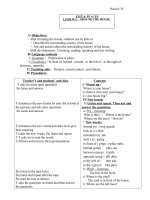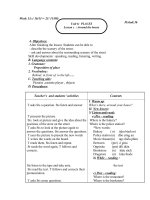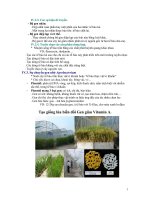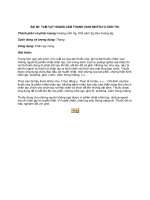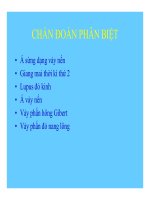bài giảng vẽ cán phần 6 pot
Bạn đang xem bản rút gọn của tài liệu. Xem và tải ngay bản đầy đủ của tài liệu tại đây (450.49 KB, 8 trang )
51
101
ME 4563 Fall ’05 Dr. S. Haran
•
•
Advantages
Advantages
–
–
Deformations of ~ 50 to 80%
Deformations of ~ 50 to 80%
–
–
Work hardening increases strength
Work hardening increases strength
–
–
Excellent surface finish
Excellent surface finish
–
–
Excellent tolerance on thickness and shape
Excellent tolerance on thickness and shape
•
•
Disadvantages
Disadvantages
–
–
High forces
High forces
–
–
Small reductions give rise to surface stresses and
Small reductions give rise to surface stresses and
non
non
-
-
uniform stress distributions
uniform stress distributions
–
–
?
?
Cold Rolling
Cold Rolling
102
ME 4563 Fall ’05 Dr. S. Haran
•
•
Input and output coils with tensioning control
Input and output coils with tensioning control
•
•
Shape meters consisting of segmented coils
Shape meters consisting of segmented coils
measuring force
measuring force
•
•
Tandem mills allow multiple reductions in one
Tandem mills allow multiple reductions in one
operation
operation
•
•
Laser inspection systems for surface finish inspection
Laser inspection systems for surface finish inspection
becoming popular (especially for canstock)
becoming popular (especially for canstock)
•
•
Surface condition of rolls critical to maintain surface
Surface condition of rolls critical to maintain surface
finish
finish
•
•
Roll bending almost essential to provide crown
Roll bending almost essential to provide crown
control
control
Cold Rolling Mill Design
Cold Rolling Mill Design
52
103
ME 4563 Fall ’05 Dr. S. Haran
Cold Rolling
Cold Rolling
-
-
Schematic
Schematic
Cold Rolling
Cold Rolling
104
ME 4563 Fall ’05 Dr. S. Haran
Cold rolled sheet can be produced in various conditions
Cold rolled sheet can be produced in various conditions
such as
such as
skin
skin
-
-
rolled
rolled
, quarter hard, half hard, full hard
, quarter hard, half hard, full hard
depending on how much cold work has been performed.
depending on how much cold work has been performed.
This cold working (hardness) is often called
This cold working (hardness) is often called
temper
temper
In
In
Skin Rolling
Skin Rolling
, the metal is reduced by 0.5 to 1% and
, the metal is reduced by 0.5 to 1% and
results in a surface that is smooth and the yield point
results in a surface that is smooth and the yield point
phenomenon
phenomenon
excessive stretching and wrinkling in
excessive stretching and wrinkling in
subsequent operations, is eliminated.
subsequent operations, is eliminated.
This makes the metal more ductile for further forming
This makes the metal more ductile for further forming
and stretching operations
and stretching operations
Cold Rolling
Cold Rolling
53
105
ME 4563 Fall ’05 Dr. S. Haran
Quarter Hard, Half Hard, Full Hard
Quarter Hard, Half Hard, Full Hard
stock have higher
stock have higher
amounts of reduction,
amounts of reduction,
upto
upto
50%.
50%.
This increases the yield point; grain orientation and
This increases the yield point; grain orientation and
material properties assume different properties along the
material properties assume different properties along the
grain orientation.
grain orientation.
However, while the yield point increases, ductility
However, while the yield point increases, ductility
decreases
decreases
Quarter Hard
Quarter Hard
material can be bent (perpendicular to the
material can be bent (perpendicular to the
direction of rolling) on itself without fracturing.
direction of rolling) on itself without fracturing.
Half hard
Half hard
material can be bent 90
material can be bent 90
º
º
;
;
Full hard
Full hard
can be bent 45
can be bent 45
º
º
.
.
Thus, these materials can be used for in applications
Thus, these materials can be used for in applications
involving great amounts of bending and deformation,
involving great amounts of bending and deformation,
without fracturing
without fracturing
Cold Rolling
Cold Rolling
106
ME 4563 Fall ’05 Dr. S. Haran
Another form of cold processing is cold drawing
Another form of cold processing is cold drawing
Steel rod is dragged at pressure (drawn) through a series
Steel rod is dragged at pressure (drawn) through a series
of dies which progressively reduce the rod's circumference to
of dies which progressively reduce the rod's circumference to
produce wire
produce wire
The drawing process substantially increases the steel's
The drawing process substantially increases the steel's
tensile strength
tensile strength
Steel wires can be spun into huge ropes strong enough to
Steel wires can be spun into huge ropes strong enough to
support the world's largest suspension bridges
support the world's largest suspension bridges
Cold Drawing
Cold Drawing
Cold Rolling
Cold Rolling
54
107
ME 4563 Fall ’05 Dr. S. Haran
Cold rolling Mill
Cold rolling Mill
Cold Rolling
Cold Rolling
108
ME 4563 Fall ’05 Dr. S. Haran
Cold rolling Mill
Cold rolling Mill
Cold Rolling
Cold Rolling
55
109
ME 4563 Fall ’05 Dr. S. Haran
Cold Rolling
Cold Rolling
Cold Rolling
Cold Rolling
110
ME 4563 Fall ’05 Dr. S. Haran
Cold rolled coil being
Cold rolled coil being
split into narrow strips
split into narrow strips
Cold rolled coils
Cold rolled coils
Cold Rolling
Cold Rolling
56
111
ME 4563 Fall ’05 Dr. S. Haran
Al Sheet being rolled
out
Rolling Aluminum
Rolling Aluminum
112
ME 4563 Fall ’05 Dr. S. Haran
Al Foil Roll
Al Foil Roll
Rolling Aluminum
Rolling Aluminum
57
113
ME 4563 Fall ’05 Dr. S. Haran
Independent Variables for Rolling
Independent Variables for Rolling
For a given rolling set
For a given rolling set
-
-
up:
up:
•
•
Roll speed
Roll speed
•
•
Draft (amount of thickness reduction) or roll gap
Draft (amount of thickness reduction) or roll gap
•
•
Billet thickness
Billet thickness
•
•
Billet width
Billet width
•
•
Billet material (not always allowed to select)
Billet material (not always allowed to select)
•
•
Billet temperature
Billet temperature
•
•
Lubricant
Lubricant
114
ME 4563 Fall ’05 Dr. S. Haran
For a given rolling set
For a given rolling set
-
-
up:
up:
•
•
Roll force
Roll force
•
•
Power
Power
•
•
Speed of exiting strip
Speed of exiting strip
•
•
Final strip temperature
Final strip temperature
•
•
Maximum draft
Maximum draft
•
•
Roll strip contact length
Roll strip contact length
•
•
Sheet or plate shape
Sheet or plate shape
Dependent Variables for Rolling
Dependent Variables for Rolling
58
115
ME 4563 Fall ’05 Dr. S. Haran
Control of Overall Properties
Control of Overall Properties
•
•
Thickness
Thickness
–
–
Roll gap which impacts roll force and hence the dimensions
Roll gap which impacts roll force and hence the dimensions
of the mill frame
of the mill frame
•
•
Width
Width
(due to spreading of slab)
(due to spreading of slab)
–
–
Edge rollers (push material back)
Edge rollers (push material back)
–
–
Edge shears (cut material off)
Edge shears (cut material off)
•
•
Length
Length
–
–
End shears
End shears
•
•
Mechanical Properties
Mechanical Properties
–
–
Controlled by the microstructures which is controlled by the
Controlled by the microstructures which is controlled by the
rolling parameters (reduction, temperature, etc)
rolling parameters (reduction, temperature, etc)
116
ME 4563 Fall ’05 Dr. S. Haran
•
•
Tolerance
Tolerance
–
–
Thickness
Thickness
•
•
Operator skill/automation
Operator skill/automation
–
–
Gauges measure thickness
Gauges measure thickness
of input and output
of input and output
–
–
Computers control roll gap
Computers control roll gap
–
–
Camber
Camber
•
•
Roll bending/automation
Roll bending/automation
–
–
Special segmented tension
Special segmented tension
meters measure "shape"
meters measure "shape"
–
–
Computers bend the rolls
Computers bend the rolls
•
•
Surface finish
Surface finish
–
–
Roll finish
Roll finish
Bearing reaction forces
Applied forces
Control of Overall Properties
Control of Overall Properties



